Amana YAMV2307PFS, YAMV2307PFW, YWMH31017HB, YWMH31017HS, YWMH31017HW Installation Instructions
...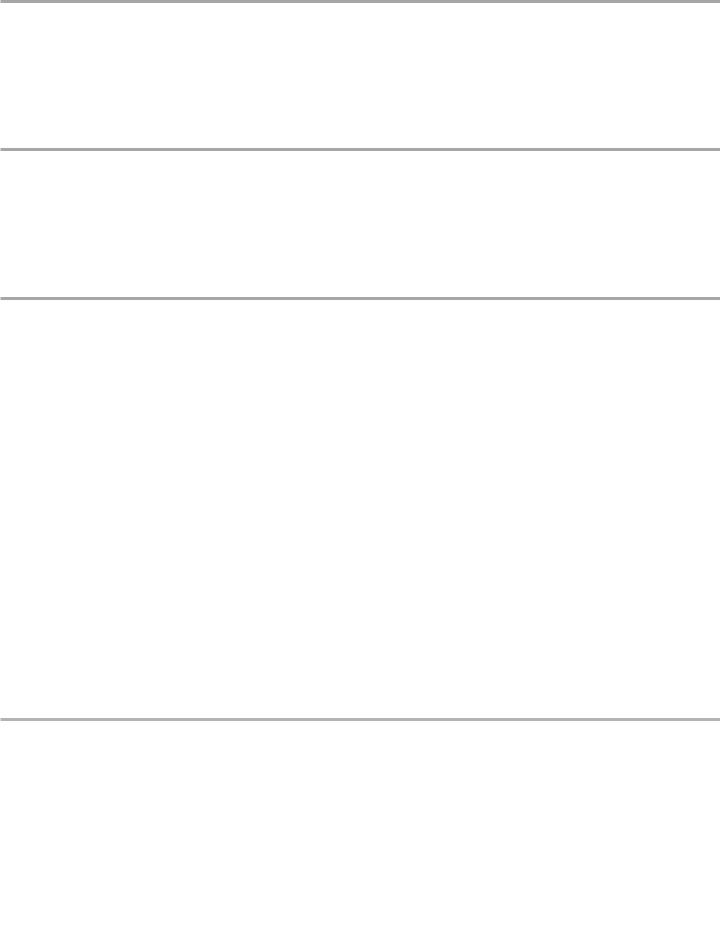
MICROWAVE HOOD COMBINATION
INSTALLATION INSTRUCTIONS
This product is suitable for use above electric or gas cooking products up to and including 36" (91.4 cm) wide. See the “Installation Requirements” section for further notes.
These installation instructions cover different models. The appearance of your particular model may differ slightly from the illustration in these installation instructions.
INSTRUCTIONS D’INSTALLATION
DE L’ENSEMBLE FOUR À MICRO-ONDES/HOTTE
Ce produit est conçu pour l’utilisation au-dessus d’appareils de cuisson électriques ou à gaz de 36 po (91,4 cm) de largeur ou moins. Voir la section « Exigences d’installation » pour d’autres remarques.
Ces instructions d’installation sont valables pour plusieurs modèles. Il se peut que l’apparence de votre propre modèle soit légèrement différente de celle montrée sur les illustrations dans ce document.
Table of Contents/Table des matières
MICROWAVE HOOD COMBINATION SAFETY |
............................2 |
INSTALLATION REQUIREMENTS................................................. |
2 |
Tools and Parts............................................................................. |
2 |
Remove Cardboard Template...................................................... |
3 |
Location Requirements................................................................ |
3 |
Product Dimensions..................................................................... |
3 |
Electrical Requirements ............................................................... |
4 |
INSTALLATION INSTRUCTIONS................................................... |
5 |
Remove Mounting Plate............................................................... |
5 |
Rotate Blower Motor.................................................................... |
5 |
Locate Wall Stud(s) ...................................................................... |
8 |
Mark Rear Wall ............................................................................. |
9 |
Drill Holes in Rear Wall............................................................... |
10 |
Attach Mounting Plate to Wall ................................................... |
10 |
Prepare Upper Cabinet .............................................................. |
11 |
Install Damper Assembly |
|
(for wall venting only).................................................................. |
11 |
Install the Microwave Oven........................................................ |
12 |
Complete Installation ................................................................. |
13 |
VENTING DESIGN SPECIFICATIONS ........................................ |
14 |
ASSISTANCE ................................................................................ |
15 |
Replacement Parts..................................................................... |
15 |
Accessories................................................................................ |
15 |
SÉCURITÉ DE L’ENSEMBLE FOUR À |
|
MICRO-ONDES/HOTTE............................................................... |
16 |
EXIGENCES D’INSTALLATION ................................................... |
16 |
Outillage et pièces...................................................................... |
16 |
Dépose du gabarit de carton ..................................................... |
17 |
Exigences d’emplacement......................................................... |
17 |
Dimensions du produit............................................................... |
18 |
Spécifications électriques.......................................................... |
18 |
INSTRUCTIONS D’INSTALLATION............................................. |
19 |
Dépose de la plaque de montage.............................................. |
19 |
Réorientation du moteur du ventilateur ..................................... |
19 |
Identifier la position du/des poteau(x) du colombage mural..... |
22 |
Tracé sur le mur arrière .............................................................. |
23 |
Perçage de trous dans le mur arrière......................................... |
24 |
Fixation de la plaque de montage sur le mur ............................ |
24 |
Préparation du placard supérieur .............................................. |
25 |
Installation du module du clapet anti-reflux |
|
(pour décharge à travers le mur uniquement)............................ |
25 |
Installation du four à micro-ondes ............................................. |
26 |
Achever l’installation .................................................................. |
28 |
SPÉCIFICATIONS/CONCEPTION DU |
|
CIRCUIT D’ÉVACUATION ........................................................... |
28 |
ASSISTANCE ................................................................................ |
30 |
Pièces de rechange.................................................................... |
30 |
Accessoires ................................................................................ |
30 |
W11485888B
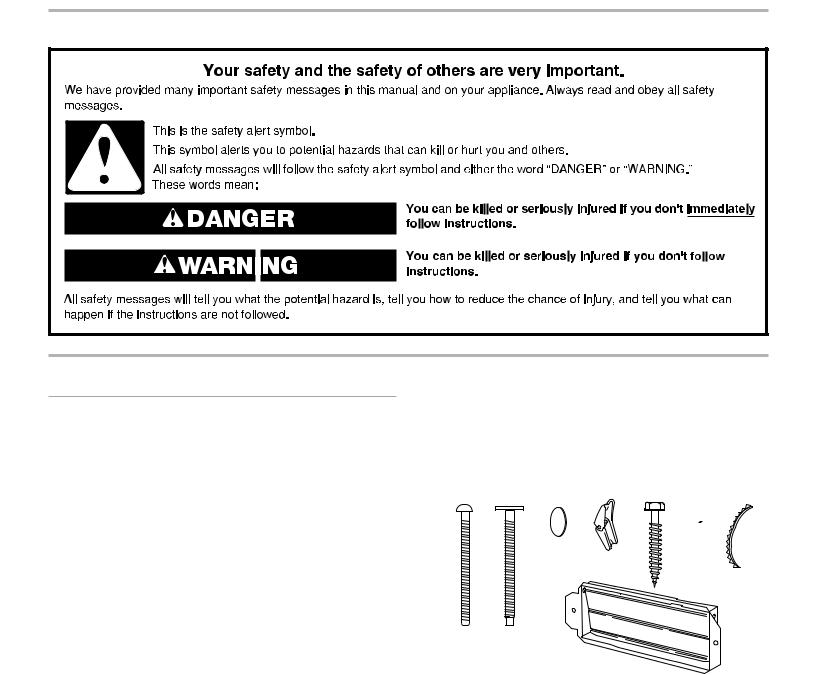
MICROWAVE HOOD COMBINATION SAFETY
INSTALLATION REQUIREMENTS
Tools and Parts
Tools Needed
Gather the required tools and parts before starting installation. Read and follow the instructions provided with any tools listed here.
■Measuring tape
■Pencil
■Masking tape or thumbtacks
■Scissors
■No. 2 Phillips screwdriver
■No. 3 Phillips screwdriver for 1/4-20 x 3" (7.6 cm) bolts
■Drill
■3/16" (5 mm), 3/8" (1 cm), 5/8" (1.6 cm) drill bits
■3/4" (1.9 cm) hole saw
■Diagonal wire cutting pliers
■Stud finder
■7⁄16" (1.1 cm) socket wrench (or box wrench) for 1/4" x 2" (6.4 mm x 5.1 cm) lag screws
■11/2" (3.8 cm) diameter hole drill bit for wood or metal cabinet
■Keyhole saw
■Caulking gun and weatherproof caulking compound
■Duct tape
Parts Needed
For information on reordering, see the “Replacement Parts” section.
NOTE: The hardware items listed here are for wood studs. For other types of wall structures, be sure to use appropriate fasteners.
A  B
B  C
C  D
D  E
E  F
F  G
G
H
A.3/16-24 x 3" round-head bolts (2)
B.1/4-20 x 3" flat-head bolts (2)
C.Washers (2)
D.3/16" toggle nuts (2)
E.1/4" x 2" lag screws (2)
F.#6 x 3/8" Sheet metal screws (2)
G.Power supply cord bushing (1)
H.Damper assembly (for wall or roof venting)
Not Shown:
■Mounting plate (attached to back of microwave oven)
■Cardboard template (part of packaging)
■Aluminum grease filters
■Charcoal filters (Depending on model, charcoal filters may not be included. See User Instructions.)
NOTE: Depending on model, aluminum grease filter and charcoal filter may be combined.
Materials Needed
Standard fittings for wall or roof venting. See the “Venting Design Specifications” section.
2
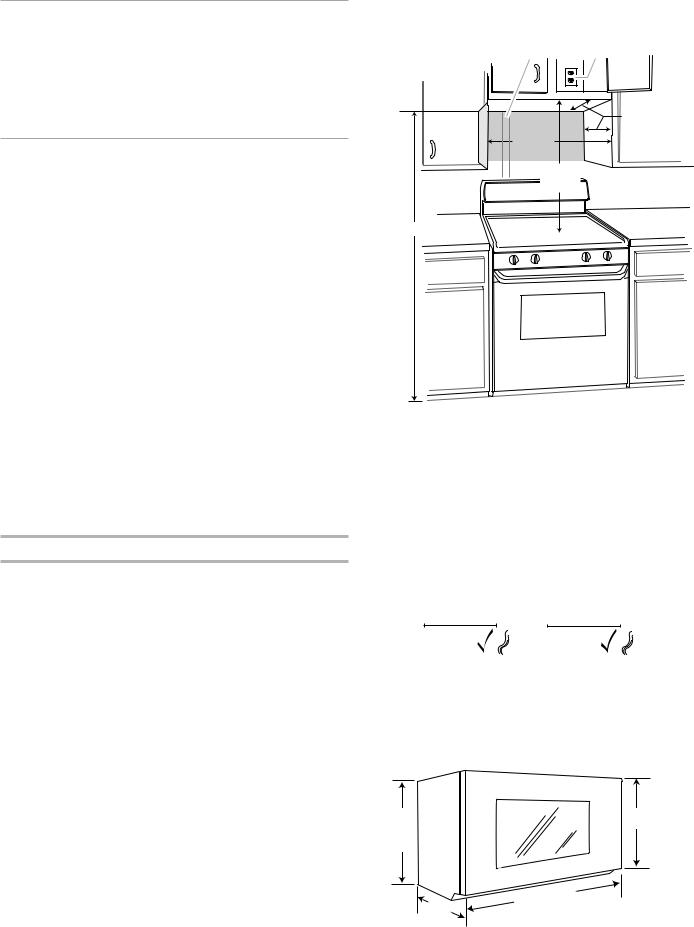
Remove Cardboard Template
The cardboard piece from the top of the microwave oven packaging is perforated. The piece inside the perforation is for use as a rear wall template and upper cabinet template.
1.Cut along the perforation to separate the template from the rest of the cardboard packaging.
2.Set the cardboard template to the side and refer to it during the “Mark Rear Wall” and “Prepare Upper Cabinet” part of installation.
Location Requirements
Check the opening where the microwave oven will be installed. The location must provide:
■Minimum installation dimensions. See the “Installation Dimensions” illustration.
■Minimum one 2" x 4" (5.1 x 10.2 cm) wood wall stud and minimum 3/8" (1 cm) thickness drywall or plaster/lath within cabinet opening.
■Support for weight of 150 lbs (68 kg) which includes microwave oven and items placed inside the microwave oven and upper cabinet.
■Grounded electrical outlet inside upper cabinet. See the “Electrical Requirements” section.
NOTES:
■If installing the microwave oven near a left sidewall, make sure there is at least 6" (15.2 cm) of clearance between the wall and the microwave oven so that the door can open fully.
■Some models have a pocket handle. If installing the microwave near a right side wall, make sure there is at least 3" (7.6 cm) of clearance between wall and microwave oven so you can grab the handle integrated inside the door.
■Some cabinet and building materials are not designed to withstand the heat produced by the microwave oven for cooking. Check with your builder or cabinet supplier to make sure that the materials used will not discolor, delaminate, or sustain other damages.
Special Requirements
For Wall Venting Installation Only:
■Cutout must be free of any obstructions so that the vent fit properly and the damper blade opens freely and fully.
For Roof Venting Installation Only:
■If you are using a rectangular-to-round transition piece, the 3" (7.6 cm) clearance needs to exist above the microwave oven so that the damper blade can open freely and fully.
See “Rectangular to Round Transition” illustration in the “Venting Design Specifications” section.
Installation Dimensions
NOTE: The grounded 3 prong outlet must be inside the upper cabinet. See the “Electrical Requirements” section.
A B
30" (76.2 cm) minimum
30" (76.2 cm) typical*
66" (167.6 cm) minimum
12" (30.5 cm) minimum 14" (35.6 cm) maximum upper cabinet and side cabinet depth
A.2" x 4" (5.1 x 10.2 cm) wall stud
B.Grounded 3 prong outlet
*30" (76.2 cm) is typical for 66" (167.6 cm) installation height. Exact dimensions may vary depending on type of range/cooktop below.
NOTE: To ensure good performance, do not obstruct top vent airflow. If cabinets are deeper than 14" (35.6 cm) but no more than 15" (38.1 cm), use the bump out mounting kit replacing the I bar mounting plate from the wall. The bump out mounting kit (part # W11185746) is not provided but can be purchased from Whirlpool.
12" DEEPER
DEEPER 14" 14"
14" 14" DEEPER
DEEPER 15"
15"
|
|
|
|
|
|
|
|
|
|
|
|
|
|
|
|
|
|
|
|
|
|
|
|
|
|
|
|
|
|
|
|
|
|
|
|
|
|
I bar mounting plate |
|
|
|
|
||
|
|
|
Bump out mounting bracket |
|||||
|
|
|
||||||
|
|
|
|
|
|
|
|
|
Product Dimensions
17¹⁄ "
(43.5 cm) +/- 3/16" (0.5 cm)
Up to |
|
17" |
|
(43. |
|
2 |
cm)* |
|
|
16¹⁄ " (41.3 cm)
|
|
.0 |
cm) |
|
" (76 |
|
|
⁄ |
|
|
|
29 |
|
|
|
*Overall depth of product will vary slightly depending on door design.
3
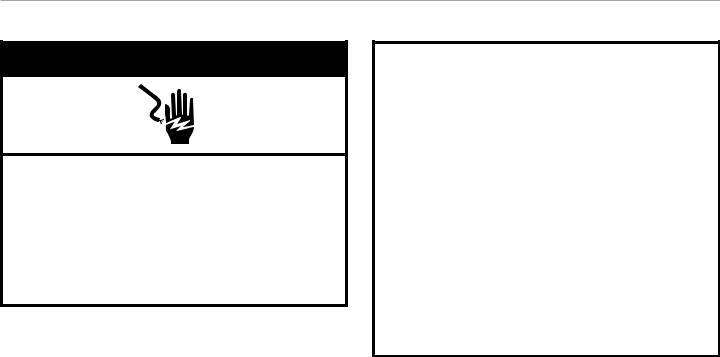
Electrical Requirements
 WARNING
WARNING
Electrical Shock Hazard
Plug into a grounded 3 prong outlet.
Do not remove ground prong.
Do not use an adapter.
Do not use an extension cord.
Failure to follow these instructions can result in death, fire, or electrical shock.
Observe all governing codes and ordinances.
Required:
■A 120 V, 60 Hz, AC only, 15 or 20 A electrical supply with a fuse or circuit breaker
Recommended:
■A time-delay fuse or time-delay circuit breaker
■A separate circuit serving only this microwave oven
GROUNDING INSTRUCTIONS
 For all cord connected appliances:
For all cord connected appliances:
The microwave oven must be grounded. In the event of an electrical short circuit, grounding reduces the risk of electric shock by providing an escape wire for the electric current. The microwave oven is equipped with a cord having a grounding wire with a grounding plug. The plug must be plugged into an outlet that is properly installed and grounded.
WARNING: Improper use of the grounding plug can result in a risk of electric shock. Consult a qualified electrician or serviceman if the grounding instructions are not completely understood, or if doubt exists as to whether the microwave oven is properly grounded.
Do not use an extension cord. If the power supply cord is too short, have a qualified electrician or serviceman install an outlet near the microwave oven.
SAVETHESE INSTRUCTIONS
4
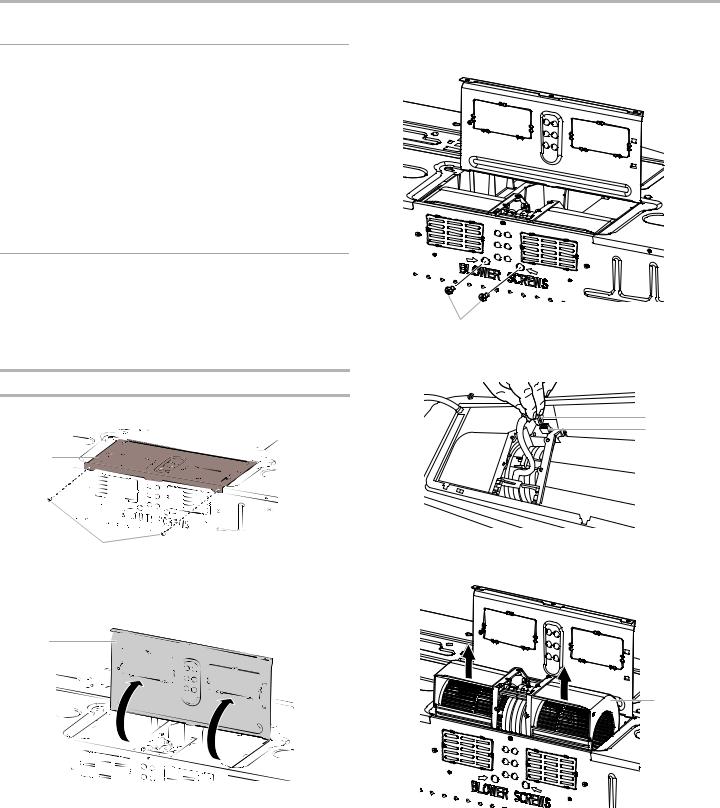
INSTALLATION INSTRUCTIONS
Remove Mounting Plate
Depending on your model, the mounting plate may be in the foam packaging, or it may be attached to the back of the microwave oven.
NOTE: To avoid possible damage, cover the work surface.
1.Remove any remaining contents from the microwave oven cavity.
2.If the mounting plate is attached to the back of the microwave oven, remove it and set it aside.
3.Tape the microwave oven door closed so that the door does not swing open while the microwave oven is being handled.
NOTE: To avoid damage to the microwave oven, do not grip or use the door or door handle while the microwave oven is being handled.
Rotate Blower Motor
The microwave oven is set for recirculation installation. For wall or roof venting, changes must be made to the venting system.
NOTE: Skip this section if you are using recirculation installation. Keep the damper assembly in case the venting method is changed, or the microwave oven is reinstalled in another location where wall or roof venting may be used.
Wall Venting Installation Only
1.Remove screws attaching damper plate to back of microwave oven, set the screws aside.
A
B
A.Damper plate
B.Screws
3.Remove two blower screws attaching blower motor to the microwave oven, and set aside.
A
A.Blower screws (in recessed holes)
4.Disconnect the blower motor wire from the connector.
A
B
A.Blower motor wire
B.Connector
5.Lift blower motor out of microwave oven, and set aside.
2. Turn and hold the damper plate vertically as shown.
A
A
A. Damper plate
A. Blower Motor
5
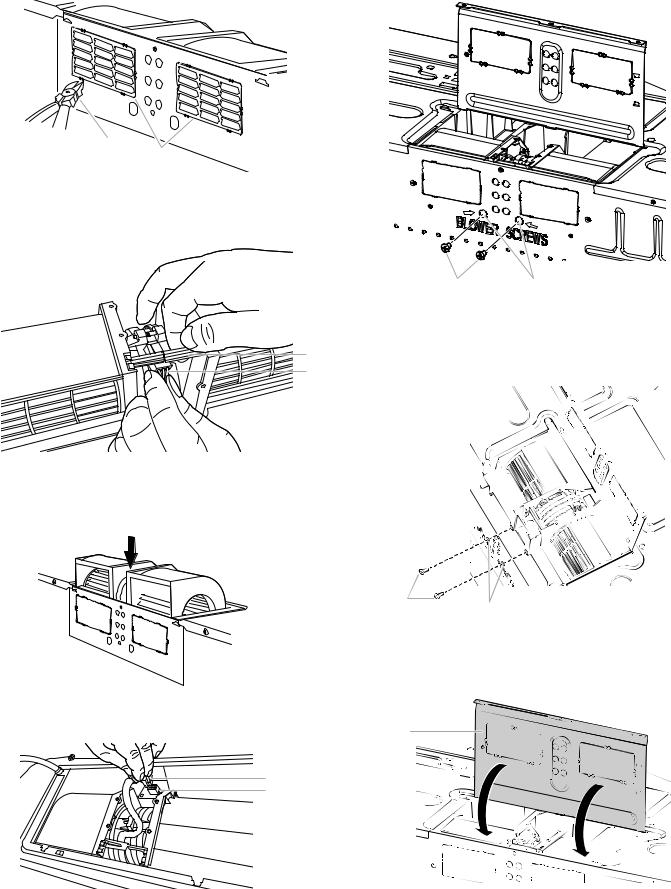
6.Using diagonal wire cutting pliers, gently snip out the rectangular damper vent covers at the perforations.
10.Reattach the two blower screws into the recessed holes in the back of the microwave.
A
B
A.Diagonal wire cutting pliers
B.Rectangular damper vent cover
7.Hold the blower motor wire, put the wire through the blower motor bridge.
A
B
A.Blower motor bridge
B.Blower motor wire
8.Lower blower motor back into the microwave oven. Exhaust ports face the back of the microwave oven.

 A
A
A.Exhaust Port
9.Reconnect the blower motor wire into the connector.
A
B
A.Blower motor wire
B.Connector
A B
A.Screws
B.Recessed holes
11.Check to make sure the two screws are secured properly in the blower motor screw holes, so that the motor cannot move.
A
B
A.Screws
B.Blower motor screw holes
12.Return the damper plate to its original horizontal position.
A
A. Damper plate
6
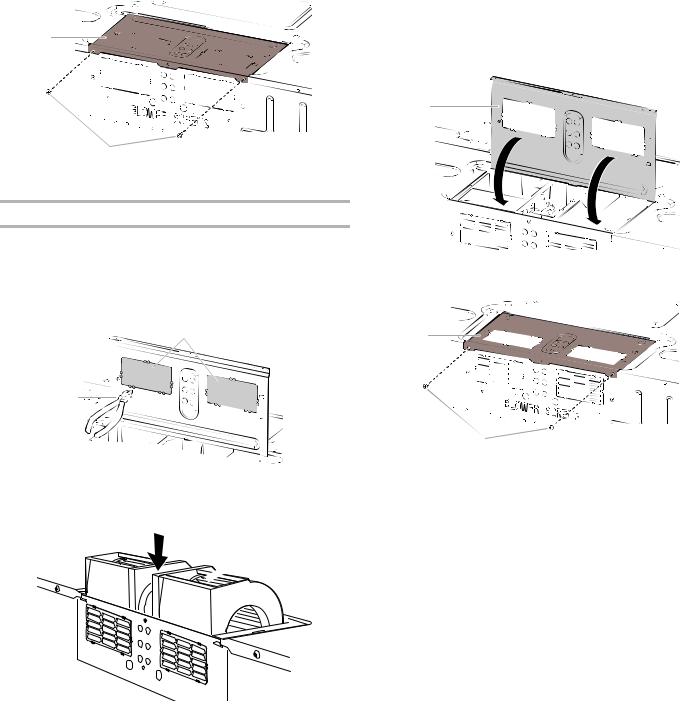
13. Secure damper plate with two screws removed in Step 1.
A
B
A.Damper plate
B.Screws
Roof Venting Installation Only
1.Repeat Step 1 from “Wall Venting Installation Only.”
2.Repeat Step 2 from “Wall Venting Installation Only.”
3.Repeat Step 3 from “Wall Venting Installation Only.”
4.Repeat Step 4 from “Wall Venting Installation Only.”
5.Repeat Step 5 from “Wall Venting Installation Only.”
6.Using diagonal wire cutting pliers, gently snip out the rectangular vent covers on the damper plate at the
perforations.
A
B
A.Rectangular vent covers
B.Diagonal wire cutting pliers
7.Lower blower motor back into microwave oven. Exhaust ports face the top of microwave oven.
 A
A
A. Exhaust port
IMPORTANT: If blower motor is not positioned with flat side facing the back of the microwave oven (as shown), performance will be poor.
8.Reconnect the blower motor wire into the connector.
9.Reattach the two blower screws into the recessed holes in the back of the microwave.
10.Check to make sure the two screws are secured properly in the blower motor screw holes, so that the motor cannot move.
11.Return the damper plate to its original horizontal position.
A
A.Damper plate
12.Secure damper plate with two screws removed in Step 1.
A
B
A.Damper plate
B.Screws
7

Locate Wall Stud(s)
NOTE: If no wall studs exist within the cabinet opening, do not |
1. |
Using a stud finder, locate the edges of the wall stud(s) |
install the microwave oven. |
2. |
within the opening. |
See illustrations in “Possible Wall Stud Configurations.” |
Mark the center of each stud, and draw a plumb line down |
|
|
each stud center. See illustrations in “Possible Wall Stud |
|
|
|
Configurations.”
Possible Wall Stud Configurations
These depictions show examples of preferred installation configurations with the mounting plate.
No Wall Studs at End Holes
Figure 1
B
C 
 C D
C D
A 

























 A
A
E E F 
|
Wall Stud at End Hole |
|
Figure 3 |
B |
D |
|
|
A |
A,D |
E |
E |
C |
C |
F |
|
No Wall Studs at End Holes
Figure 2
C B D
A |
A |
E |
E |
F
NOTE: If wall stud is within 6" (15.2 cm) of the vertical centerline (see the “Mark Rear Wall” section), only recirculation or roof venting installation can be done.
|
Wall Studs at End Holes |
|
Figure 4 |
B |
|
A,D |
A,D |
E |
E |
C |
C |
F |
|
A.End holes (on mounting plate)
B.Cabinet opening vertical centerline
C.Wall stud centerlines
D.Holes for lag screws
E.Support tabs
F.Mounting plate center markers
8
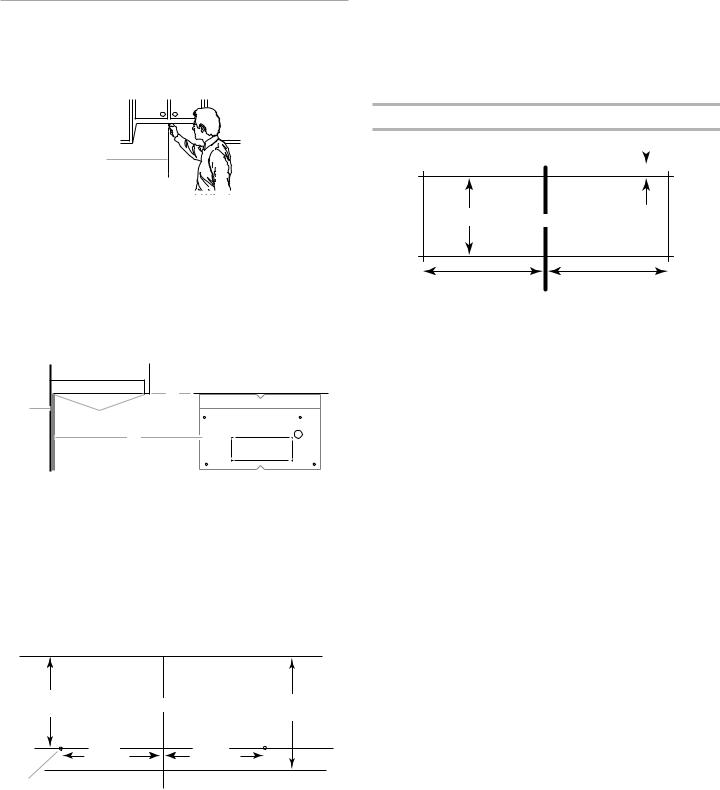
Mark Rear Wall
The microwave oven must be installed on a minimum of one wall stud, preferably two, using a minimum of one lag screw, preferably two.
1.Using measuring tape, find and clearly mark the vertical centerline of the opening.
6.Holding the mounting plate in place, find the wall stud centerline(s) drawn in Step 2 of “Locate Wall Stud(s)” and mark at least one, preferably two hole(s) through the mounting plate, closest to the wall stud centerline(s). See
figures 1, 2, and/or 3 in “Possible Wall Stud Configurations” in the “Locate Wall Stud(s)” section. The blackened holes in the shaded areas are ideal hole locations.
7.Set the mounting plate aside.
Wall Venting Installation Only
A
A.Centerline
2.Align the center markers on the cardboard template (carton top cap), to the centerline on the wall, making sure it is level, and that the top of the cardboard template is butted up against the bottom edge of the upper cabinet.
NOTES:
■If the front edge of the upper cabinet is lower than the back edge, lower the cardboard template so that its top is level with the front edge of the cabinet.
■If the cardboard template is damaged or unusable, measure and mark the wall with the dimensions described in Step 4.
D |
A |
C |
B |
A.Rear wall
B.Cardboard template
C.Top of cardboard template must align with front edge of cabinet.
D.Front edge of upper cabinet
3.Holding the cardboard template in place, mark both holes in the lower corners and draw a horizontal line across the
bottom edge of the cardboard template. These represent the mounting plate’s end holes and bottom edge.
4.Remove the cardboard template and check the markings:
Upper cabinet bottom
15 ⁄ "
(39.71 cm)
Centerline 17¹⁄ "
(44.02 cm)
|
|
14¹⁄ " |
|
14¹⁄ " |
|
|
|
|
|
|
|
||
|
|
(35.96 cm) |
|
(35.96 cm) |
|
|
|
|
|
|
|
|
|
Bottom of mounting plate
Mounting plate end hole
■The bottom edge line must be 171⁄3" (44.02 cm) from the bottom of the upper cabinet and must be level.
■The end holes must be 155⁄8" (39.71 cm) from the bottom edge of the upper cabinet and must be on a level line with
each other. They must each be 141⁄8" (35.96 cm) from the centerline.
5.With the support tabs facing forward (see illustrations in the “Locate Wall Stud(s)” section), align the mounting plate center markers to the centerline on the wall, making sure its
bottom edge is aligned to the horizontal line drawn in Step 3 and that the end holes are properly marked. Make sure the mounting plate is level.
Upper cabinet bottom |
|
3/8" (1 cm) |
|
4" (10.2 cm) |
Centerline |
6" (15.2 cm) |
6" (15.2 cm) |
8.Mark the centerline 3/8" (1 cm) down from the bottom edge of the upper cabinet.
9.Using measuring tape, measure out 6" (15.2 cm) on both sides of the centerline, and mark.
10.Measure down 4" (10.2 cm) from the mark made in Step 8 and mark.
11.Using a straightedge, draw the two horizontal, level lines through the marks made in steps 8 and 10.
12.Draw the two vertical plumb lines down from the marks made in Step 9 to complete the 12" x 4" (30.5 x 10.2 cm) rectangle. This is the venting cutout area.
13.Cut a 3/4" (1.9 cm) hole in one corner of the cutout area.
14.Using a keyhole saw, cut out the venting cutout area.
9
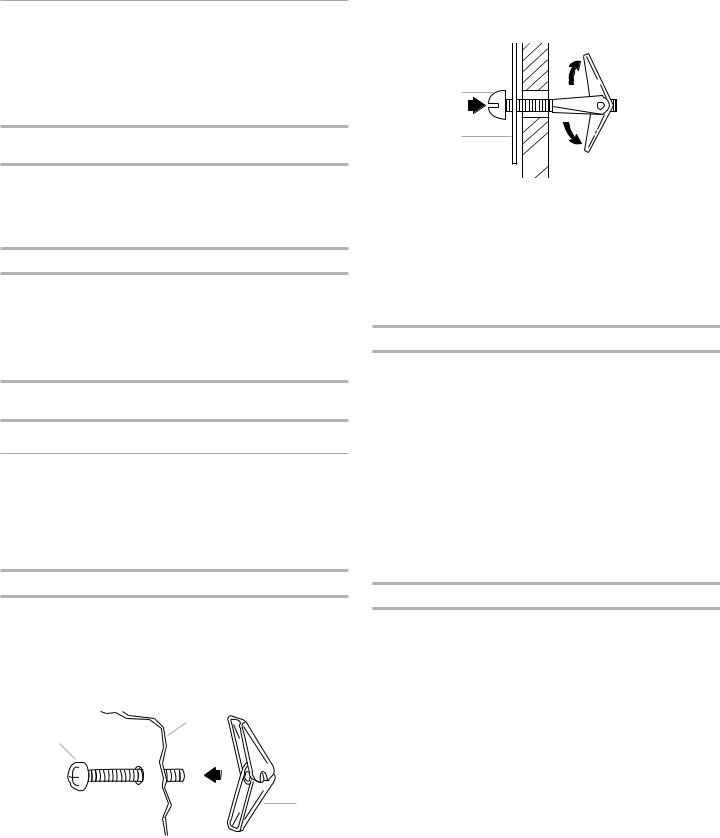
Drill Holes in Rear Wall
In addition to being installed on at least one wall stud, the mounting plate must attach to the wall at both end holes. If the end holes are not over wall studs, use two 3/16-24 x 3" round-head bolts with toggle nuts; if one end hole is over a wall stud, use one lag screw and one 3/16-24 x 3" round-head bolt with toggle nut; or if both end holes are over wall studs, use two lag screws. Following are three installation configurations.
Installation for No Wall Studs at End Holes (Figures 1 and 2)
1.Drill 5/8" (1.6 cm) holes through the wall at both end holes marked in Step 3 of the “Mark Rear Wall.”
2.Drill 3/16" (5 mm) hole(s) into the wall stud(s) at the hole(s) marked in Step 6 of the “Mark Rear Wall.” Refer to figures 1 and 2 in “Possible Wall Stud Configurations” in the “Locate Wall Stud(s)” section.
Installation for Wall Stud at One End Hole (Figure 3)
1.Drill a 3/16" (5 mm) hole into the wall stud at the end hole marked in Step 3 of the “Mark Rear Wall.”
2.If installing on a second wall stud, drill a 3/16" (5 mm) hole into the wall stud at the other hole marked in Step 6 of the “Mark Rear Wall.” Refer to Figure 3 in “Possible Wall Stud Configurations” in the “Locate all Stud(s)” section.
3.Drill a 5/8" (1.6 cm) hole through the wall at the other end hole.
Installation for Wall Studs at Both End Holes (Figure 4)
1.Drill 3/16" (5 mm) holes into the studs at the end holes marked in Step 3 of the “Mark Rear Wall.”
Attach Mounting Plate to Wall
NOTE: Secure the mounting plate to the wall at both end holes drilled into the wall studs and/or drywall using either
3/16-24 x 3" round-head bolts and toggle nuts or 1/4 x 2" lag screws.
Refer to illustrations in “Possible Wall Stud Configurations” in the “Locate Wall Stud(s)” section.
No Wall Studs at End Holes (Figures 1 and 2)
NOTE: The mounting plate must be secured to the wall on at least one wall stud as well as at both ends.
1.With the support tabs of the mounting plate facing forward, insert 3/16-24 x 3" round-head bolts through both end holes of mounting plate.
2.Start toggle nuts on bolts from the back of the mounting plate. Leave enough space for the toggle nuts to go through the wall and to open.
B
A
C
A.3/16-24 x 3" round-head bolt
B.Mounting plate
C.Spring toggle nut
3.Position mounting plate on the wall.
4.Push the two bolts with toggle nuts through the drywall, and finger tighten the bolts to make sure toggle nuts have opened against drywall.

 C
C
A
B
 D
D
A.3/16-24 x 3" round-head bolt
B.Mounting plate
C.Spring toggle nut
D.Drywall
5.Insert lag screw(s) into the hole(s) drilled into wall stud(s) in Step 2 of “Installation for No Wall Studs at End Holes” in the “Drill Holes in Rear Wall” section.
6.Check alignment of mounting plate, making sure it is level.
7.Securely tighten all lag screws and bolts.
Wall Stud at One End Hole (Figure 3)
1.With the support tabs of the mounting plate facing forward, insert a 3/16-24 x 3" round-head bolt through the end
hole that fits over the 5/8" (16 mm) hole drilled in Step 3 of “Installation for Wall Stud at One End Hole” in the “Drill Holes in Rear Wall” section.
2.Start a toggle nut on the bolt from the back of the mounting plate. Leave enough space for the toggle nut to go through the wall and to open.
3.Position mounting plate on the wall.
4.Push the bolt with toggle nut through the drywall, and finger tighten the bolt to make sure toggle nut has opened against drywall.
5.Insert a lag screw into the remaining end hole.
6.If installing on a second wall stud, insert a lag screw into the other hole drilled in Step 2 of “Installation for Wall Stud at One End Hole” in the “Drill Holes in Rear Wall” section.
7.Check alignment of mounting plate, making sure it is level.
8.Securely tighten the lag screw(s) and bolt.
Wall Studs at Both End Holes (Figure 4)
1.Position mounting plate on the wall.
2.Insert lag screws into both end holes.
3.Check alignment of mounting plate, making sure it is level.
4.Securely tighten the lag screws.
10
